bubo...noctis monstrum, nec cantu aliquo vocalis sed gemitu. itaque in urbibus aut omnino in luce visus dium ostentum est.
A monster of the night, its call not a song but a groan, the sight of an owl in the city or anywhere in daylight is a dire portent.
(Pliny the Elder, Nat.Hist., X.xvi. 33-36)
 N 83, UNDER DOMITIAN'S personal direction, the Roman mint initiated a series of four Minerva reverses on regular issues of silver denarii, which would continue to be struck until the end of his reign in 96. Commonly referred to as M1, M2, M3, and M4, after the order of their appearance in the British Museum catalog, these reverses (below RIC 563, RIC 576var, RIC 519, and RIC 339) reveal the Roman goddess Minerva in four different aspects.
N 83, UNDER DOMITIAN'S personal direction, the Roman mint initiated a series of four Minerva reverses on regular issues of silver denarii, which would continue to be struck until the end of his reign in 96. Commonly referred to as M1, M2, M3, and M4, after the order of their appearance in the British Museum catalog, these reverses (below RIC 563, RIC 576var, RIC 519, and RIC 339) reveal the Roman goddess Minerva in four different aspects.

When we study the four coin reverses, it becomes immediately apparent that the four aspects of the goddess depict only three different poses, M1 and M2 sharing the same pose. In fact upon close examination M1 Minerva appears identical to M2 Minerva in every way, the same belligerent stance on archaic tiptoe, left foot forward, right arm raised with javelin, the same round shield on her left arm, the same crested helmet on her right-facing head, the same long, belted chiton, its heavy placket dropping between her knees, and the same aegis billowing out in a peplos of live snakes, the very same snakes apparently. Here, for comparison's sake, are the two reverses side by side, both from the second issue of 87 A.D., RIC 517 and RIC 518 var--

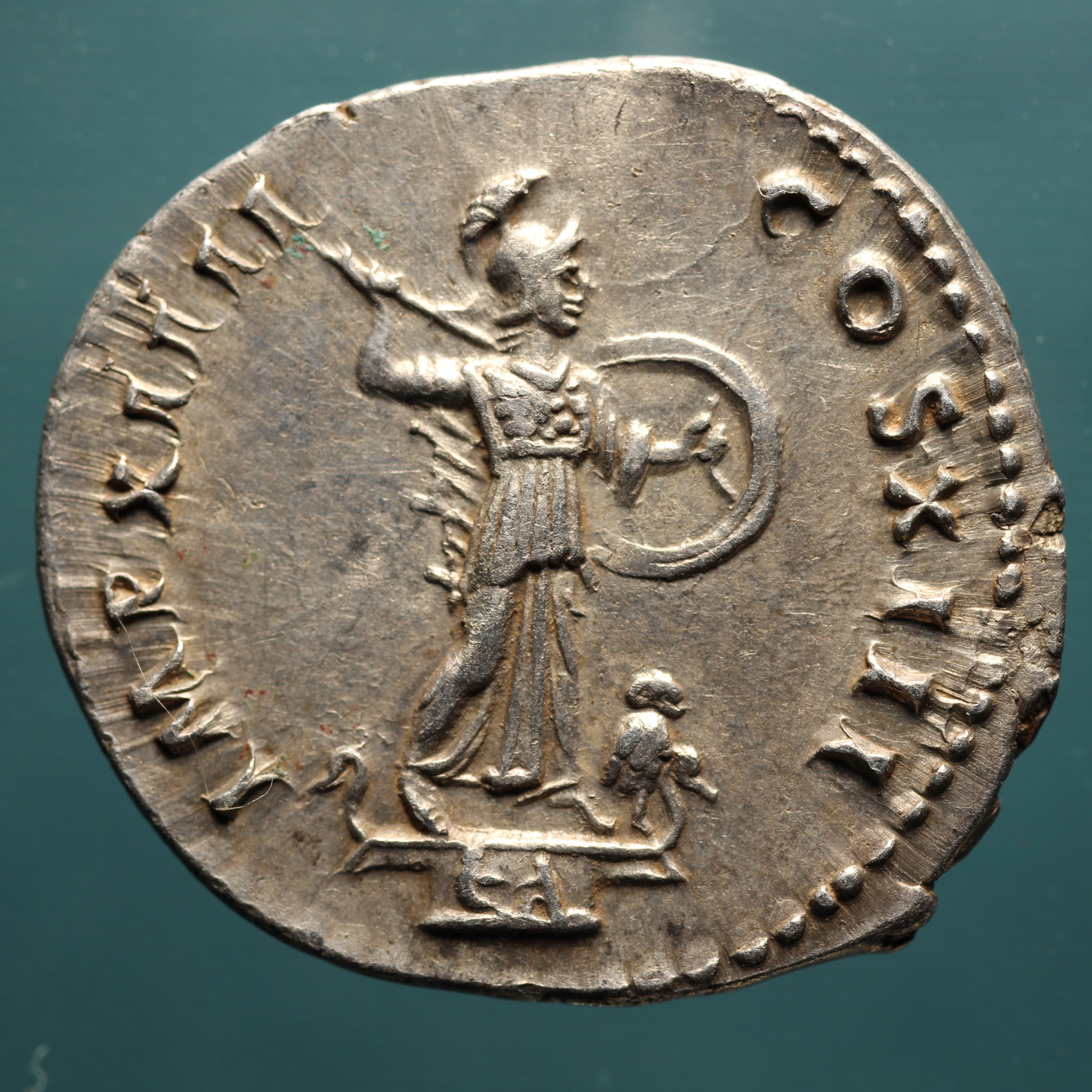
The same statue, but a question arises. In 83 there were over a dozen noteworthy public statues of Minerva in the city of Rome, including at least five temple cult statues (by 96 there would be at least eight), so why did Domitian instruct the mint to waste two slots, M1 and M2, on the same statue. Since M2 has the added value of an owl and a decorated base of some sort, why not keep that one and replace M1 with a different cult statue?
The answer, I discovered, they are not the same statue after all!
Last month we looked at M1, the cult statue of the Temple of Minerva on the Aventine Hill, Minerva’s principle aedes in Rome. In my opinion, M2 depicts a replica of that statue, a smaller, lighter, more portable, less fragile, less valuable replica, called an ἀπεικόνισμα, used processionally to avoid damaging the real article. Isn’t that interesting! All of a sudden we can turn the first question upside-down: If M1 is the actual cult statue, why show us the replica at all, why is there an M2 in the first place?
To answer this second question I believe we must identify what Minerva M2 is standing on, and we must also understand the significance of the owl.
RIC (Carradice and Buttrey, The Roman Imperial Coinage, Volume II, London, 2007) identifies the platform Minerva stands on in the M2 reverse as the capital of a rostral column.
Trouble is, this is not the way the rostral columns were depicted on coins. Here is a denarius, RIC (V)1066, from the David Atherton coll.--
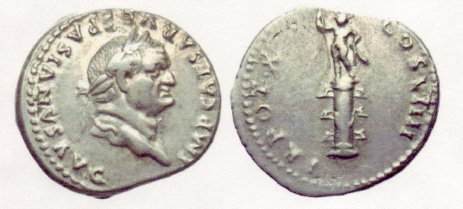
The reverse of this coin presents the statue and the rostral column in their entirety. The objects jutting out from the sides of the column are the bronze ramming beaks (rostra) taken from warships at Antium, and these are what give the column its name. Note that there aren’t any gooseneck projections rising from the top of the column.
Furthermore this is not what the capital of a Roman column looks like. Note also what appears to be a pictorial frieze on M2, the area directly beneath Minerva's feet. There is never a frieze on a classical column, and certainly not on the column's capital. Even Trajan's Column, which will break all the rules a generation later with a pictorial frieze wrapping around it bottom-up like a corkscrew, doesn't attempt to continue the enwrapping frieze to the very top of the column, which in fact is topped by a simple Doric capital.
Then if not a rostral column, what is it that Minerva M2 is standing on!
In my opinion, what is depicted is an apparatus, in particular, a very specialized conveyance called a ferculum, a processional litter used in military triumphs and, more regularly, in the circus parade, the pompe circensis. Here is a familiar example of a triumphal, ad hoc processional litter from the Arch of Titus in Rome--
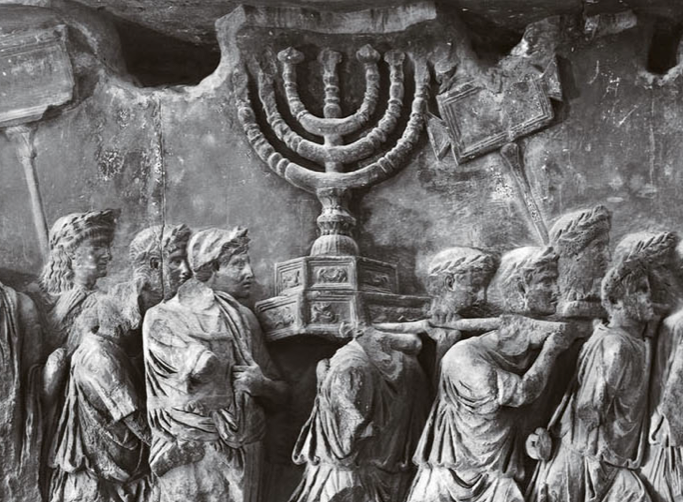
Here is another example in the Louvre of a ferculum used in the pompe circensis--

David Atherton supplies a third example, the Magna Mater--
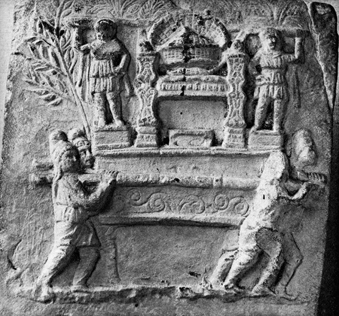
The M2 replica of the Aventine Minerva would have been carried in procession right along with the three of these. Ovid mentions spotting the goddess Minerva (in my opinion, this very same ἀπεικόνισμα mounted onto this very same ferculum) in the distance while he attempts to seduce another man’s wife--
Sed etiam pompa venit--linguis animisque favete!
Tempus adest plausus--aurea pompa venit…
Artifices in te verte, Minerva, manus!
Already the parade arrives--silence your hearts and tongues of any bad omen! It’s time to applaud--the golden parade is here... Minerva, nod to the applauding hands of your own craftsmen!
(Amores, iii, 2.43-52)
Compare the two fercula above with the M2 reverses below, RIC 730 on the left showing just the apparatus itself; RIC 427 on the right, the ferculum with (truncated) poles attached--

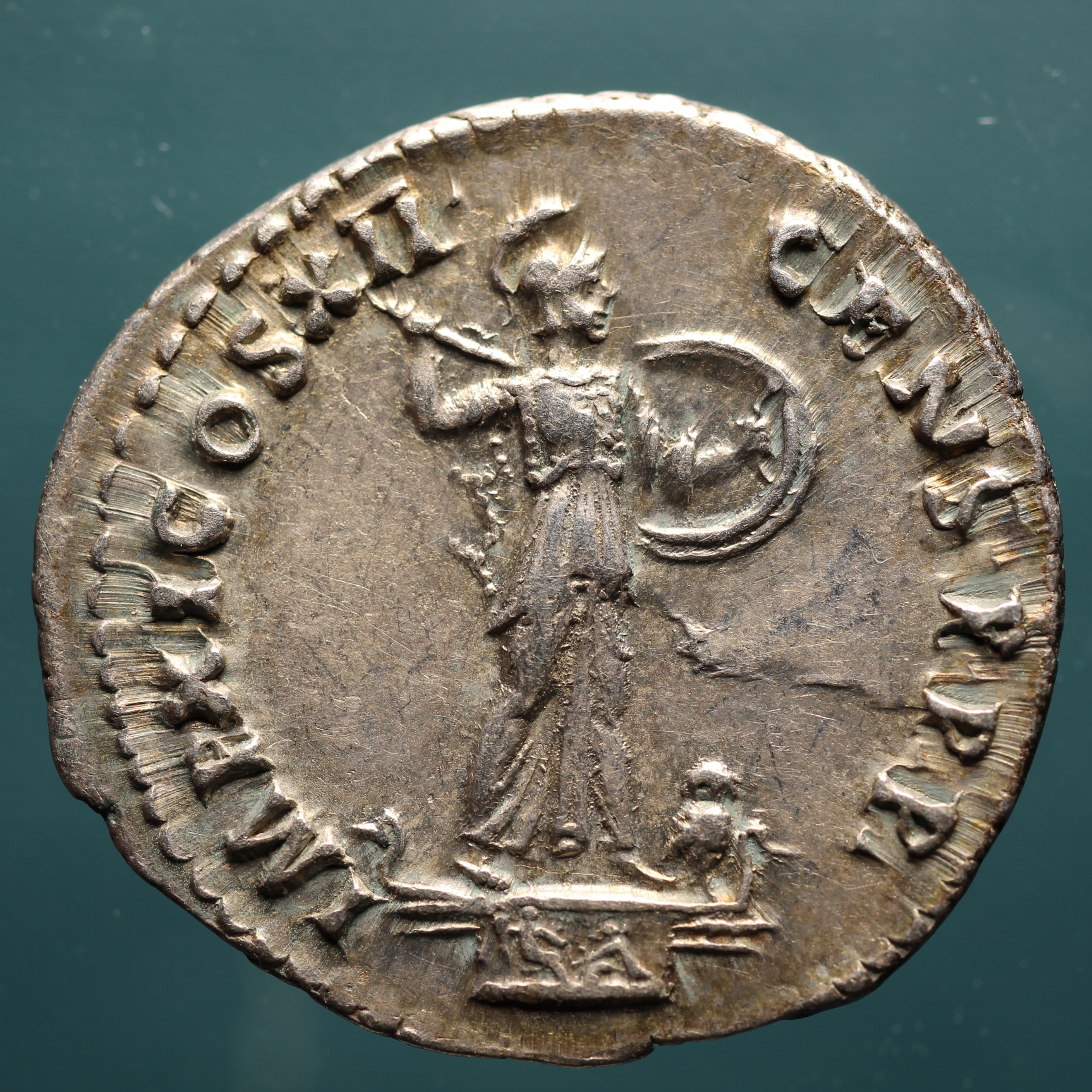
I am identifying the picture on the side of the litter with the story of Arachne, specifically Arachne presenting her cloth to Minerva for judgment. This story seems to have been especially dear to the Aventine Temple (Eve d'Ambra, Private Lives Imperial Virtues, the frieze of the Forum Transitorium in Rome, Princeton, 1993). Note that the coin on the right (especially) shows Minerva enthroned; this would have been the typical representation of the goddess at home in her aedes.
Now, about the owl. Numismatically-speaking the owl isn’t necessary, neither from a practical standpoint nor an aesthetic one. It isn’t necessary to add as an attribute because everyone in Rome would have recognized this depiction of Minerva as the Aventine’s ἀπεικόνισμα, owl or no owl. It isn’t necessary as a design feature either. There really isn’t any room for it on the ferculum, and arguably the ferculum looks better without it, more balanced. It seems obvious to me that when the actual ferculum was constructed for the actual ἀπεικόνισμα the owl wasn’t included in the calculation, or else there would have been a space built in for the poor bird so that Minerva wouldn't have to be constantly tripping over it. Here is an example (RIC 690 var) where the engraver omitted the owl by accident--

A person could safely argue from a design standpoint that the coin is better off without it. I say this with some degree of confidence in so much as my university degree is in art (B.F.A.-painting, UW-E.C., 1999). But there is, in fact, an owl on the standard M2 reverse, so what is the deal with the owl?
In my opinion, something momentous must have happened in 76 or shortly before, when Domitian was only 25, something involving the owl. Romans had a superstitious fear of owls; encountering one in the daytime was particularly dreadful; to have one appear, for example, in the middle of a religious ceremony would be enough to cancel the proceedings entirely or at least to force their rescheduling for another day and only after a prolonged ritual of purification! In the case of a festival of games, which were, at their core, religious in nature, this would be disappointing for the people and expensive for the city or for the individual presenting the games.
So when this dreaded, cursed owl appeared in the early daylight hours at the beginning of one of Rome’s innumerable festivals in 76, during the all-important circus parade, the magistrates in charge were ready to throw up their hands and call it quits for the day, quits for the entire festival. This was a disaster, a total, unmitigated disaster. It was then, at the most opportune moment imaginable, that the cadet limb of the imperial family whose pronouncement carried the weight of the emperor himself, the young priest Caesar Domitian (perhaps in his role as Augur or perhaps as a member of the College of Fifteen [ILS 267]), calmly pointed out to everybody what was right before their eyes--whither the owl had lit, on the Aventine Temple’s own ferculum, at Minerva’s own feet! Here was a bird that was sacred to the goddess, despite the common wisdom about owls, her avian familiar, being called to heel at her feet! This wasn’t a disaster, my goodness! This was indeed a miraculous event! Yay! The festival could continue!
I believe that this might be what happened in 76. In addition to being named Hero of the Day, the incident affected Domitian deeply. He took it as a personal sign of favor from the goddess who had visited him in dreams, a sign of his destiny, not in support of his imperial aspirations--I don’t believe that the future emperor had any imperial aspirations, not really, I don’t believe he was ever in the habit of carrying the baton of empire around in his knapsack--but in support of his literary aspirations. Domitian was already a writer of significant note, a gifted and celebrated poet and the author of a comic, self-deprecating essay on the subject of baldness and its cures. Although dedicated to craftsmen generally, Minerva’s Temple on the Aventine was a haunt of poets and writers in Rome, and here was a miraculous intervention by that temple’s patron goddess herself.
Afterward when Domitian met with Claudius Etruscus, the director of the mint, in order to commemorate this important moment in his life with an appropriate denarius, Claudius Etruscus baulked. “Your face might be on the front, sonny-boy,” the mint director spoke with some heat, “but it’s still the imperial coinage, and we’re not about to put a circus parade prop on the back of one of your dad’s coins!” So an unsatisfying compromise was reached in RIC (V)920, shown here from the Alberto Tricarico coll.--
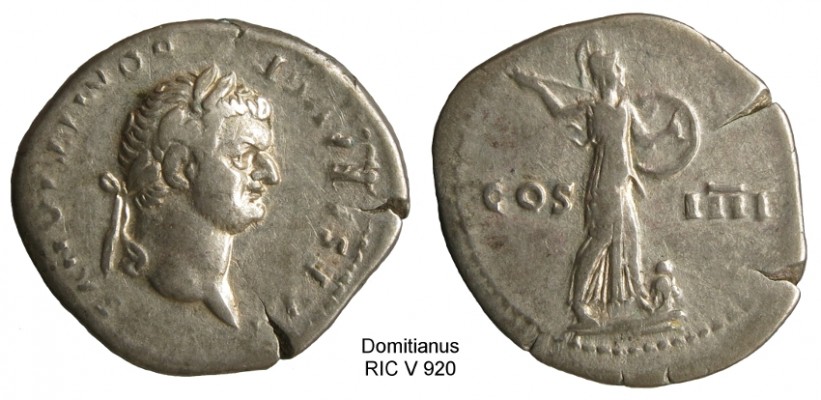
Instead of the ferculum with its gooseneck appendages (first-century visual shorthand for the deck of a warship) we see Minerva standing with the owl on the prow of an actual warship. No doubt Claudius Etruscus was able to cite precedent from the coinages of Ionian Lebedos and Lycian Phaselis in support of this half-measure (Wolfgang Schürmann, Typologie und Bedeutung der stadtrömischen Minerva-Kultbilder, Rome, 1985).
Soon upon the occasion of Domitian’s elevation to the throne of Augustus, Claudius Etruscus was banished from Rome, perhaps having called the emperor “sonny-boy” once too often. (Ian Carradice has already written on the matter, "The banishment of the father of Claudius Etruscus: numismatic evidence," LCM 4.5 [May, 1979], 101-3. Everything I happen to know about the subject, including where to find it in Statius [Silvae 3.3], I learned from Prof Carradice's article after he so kindly emailed it to me. Of course the title of the paper cited is correct, it is the father of Claudius Etruscus that Statius [and Martial, vii.40] eulogizes to the son, but that construction proved too cumbersome to use four times in my text; besides they probably shared the same name anyway.)
Meanwhile the owl, an actual, living owl sacred to the Aventine precinct, no doubt trained or tethered to the processional litter itself, was elevated as well, to a permanent spot on the Aventine parade ferculum.

